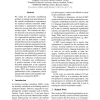Free Online Productivity Tools
i2Speak
i2Symbol
i2OCR
iTex2Img
iWeb2Print
iWeb2Shot
i2Type
iPdf2Split
iPdf2Merge
i2Bopomofo
i2Arabic
i2Style
i2Image
i2PDF
iLatex2Rtf
Sci2ools
ACL
2010
2010
Unsupervised Search for the Optimal Segmentation for Statistical Machine Translation
We tackle the previously unaddressed problem of unsupervised determination of the optimal morphological segmentation for statistical machine translation (SMT) and propose a segmentation metric that takes into account both sides of the SMT training corpus. We formulate the objective function as the posterior probability of the training corpus according to a generative segmentation-translation model. We describe how the IBM Model-1 translation likelihood can be computed incrementally between adjacent segmentation states for efficient computation. Submerging the proposed segmentation method in a SMT task from morphologically-rich Turkish to English does not exhibit the expected improvement in translation BLEU scores and confirms the robustness of phrase-based SMT to translation unit combinatorics. A positive outcome of this work is the described modification to the sequential search algorithm of Morfessor (Creutz and Lagus, 2007) that enables arbitrary-fold parallelization of the computa...
ACL 2010 | Adjacent Segmentation States | Computational Linguistics | Optimal Morphological Segmentation | SMT Training Corpus |
| Added | 10 Feb 2011 |
| Updated | 10 Feb 2011 |
| Type | Journal |
| Year | 2010 |
| Where | ACL |
| Authors | Coskun Mermer, Ahmet Afsn Akn |
Comments (0)

